How much do you know about the deer species? I bet pretty much! But here are even more facts about deer you should know.
Deer are some of the most interesting mammals you’ll find on Earth. Almost everywhere in the world, there’s an entire list of species of deer.
But how can you identify a deer?
The term deer describes several mammal species with a combination of hooves and antlers. While there’s more to what makes a deer, that is the most basic definition.
You might not have known the many interesting things about the deer species. For example,
- Did you know that most species shed and regrow their antlers once a year?
- Did you know that there is a certain species of water deer that has fangs instead of antlers like most other deer?
- And did you know reindeer is the only domesticated species, has horns like branches, and lives in the northern parts of the world?
As it turns out, deer are interesting species with many unique facts.
Here are more than 10 facts about deer you need to know:
TOP Fun & Interesting Facts about the Deer Family
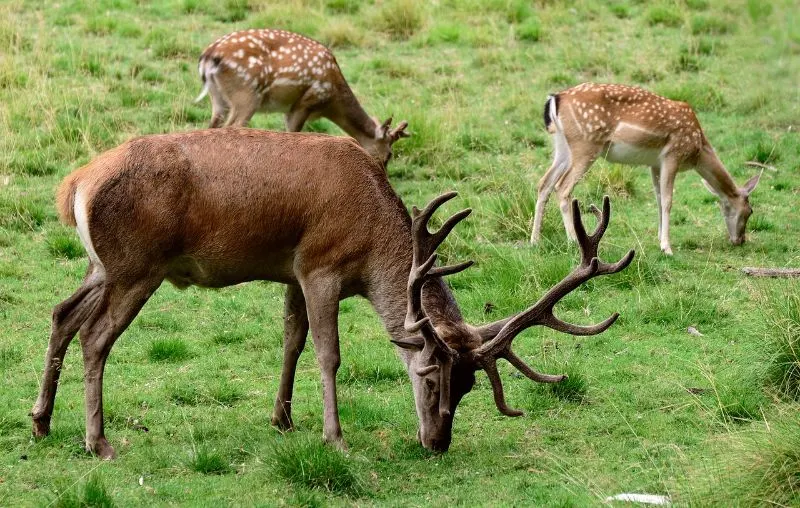
1. There are more than 40 different types of deer species globally.
Deer are a very diverse mammal species. There are more than 40 different species of deer in the world. They range from the red deer found in Scotland and mule deer indigenous to Western North America to the whitetail deer found throughout North and Central America.
Male deer species are called bucks, while female deer are referred to as does. Baby deer are not called kittens or puppies but fawns, the same term used for horses.
Most deer species don’t go about life alone but cluster together in small to moderate groups. A collection or grouping together of deer is called a herd.
The white-tailed deer, the red deer, and the moose are all species of deer that you might find spread throughout the world’s ecosystems. They have adapted to the different world climates.
See Related: War and Effect on Wildlife
2. The moose is one of the world’s largest deer species.
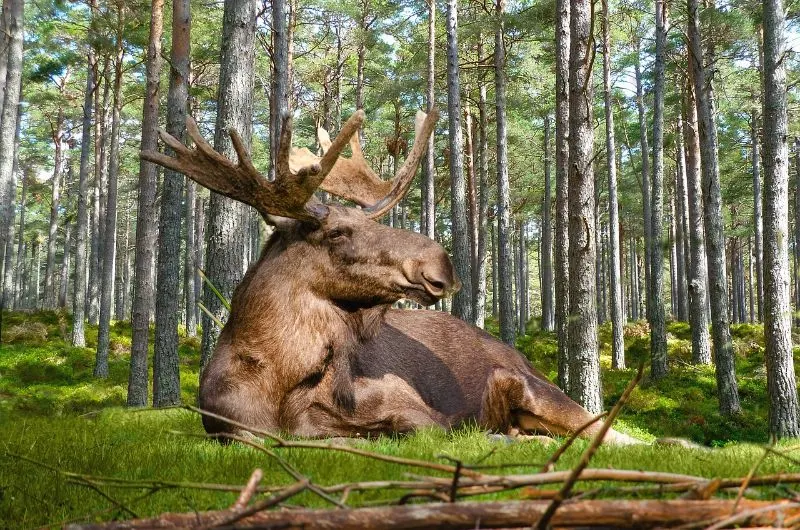
The moose is a type of deer found throughout North America and parts of the United States. Officially, it is one of the largest deer species and the one most people can easily name.
A moose can grow up to 6.5 feet high and weigh as much as 1 800 pounds. That’s huge, especially compared to the white-tailed deer, the smallest deer species found predominantly in North and Central America.
Even though moose numbers are high, they are not as plentiful in nature as before. Their numbers have significantly decreased thanks to decades of deforestation and hunting.
See Related: Animals That Start With V
3. Deer populations around the world are on the decline.
Some species of deer are commonly found in large numbers, such as the white-tailed deer. However, other types are considered endangered, threatened, near-threatened, or rare.
Even worse, some are extinct, like the Irish elk. The Irish elk was the largest species to ever exist and has been extinct for over 11,000.
Deforestation, hunting, and habitat loss are the primary culprits contributing to this problem. As a result, it means that many of the world’s deer species are on the world’s list of protected animals.
Usually, deer live in the fields and woodlands in summer. They also go to the forests to protect themselves from the winter cold.
But deer have no place to hide in winter when people cut down trees. They are more likely to come to the parks and yards.
While species like the white-tailed deer and moose are common, ones like the chevrotain are pretty rare. These might disappear entirely if sustainable efforts are not supported.
Current deer populations were measured at less than 4 million in 2020. If the decline continues, many of the species we know today might be completely lost.
See Related: These 13 Animals Have the Best Hearing in the World
4. Deer are called ‘deer’ thanks to certain special characteristics.
Deer are classified as deer thanks to specific characteristics that only approximately 40 species share. One of the common characteristics of deer species is the antlers. Deer antlers, to which only the Chinese water deer is the exception, are unique – at least as far as scientists can establish today!
The other unique characteristic of deer species is their feet. Like many other herbivores, their feet are split-hooved. However, they have an extra pair of tiny hooves above the larger ones, at the back of their legs.
If you keenly observe their footprints, you can see what makes the hooves unique. The shape of their feet allows deer to have a superior grip in their habitats. Whether found in snow or wetlands, a deer’s feet are perfectly adapted to survive.
See Related: Conservation vs. Preservation
5. Deer have a very large range in nature.
When found in their natural habitat, deer have a very large range, estimated to be around one square mile. Deer stick together in packs, and this approximate range is true for most deer species on Earth.
The home range is where deer will spend most of their lives. Foraging and eating are generally done in this home stretch area. Rarely some deer varieties can expand their range up to three times more than this.
See Related: List of Most Endangered Deer Species
6. Deer have an average gestation period of 200-205 days.
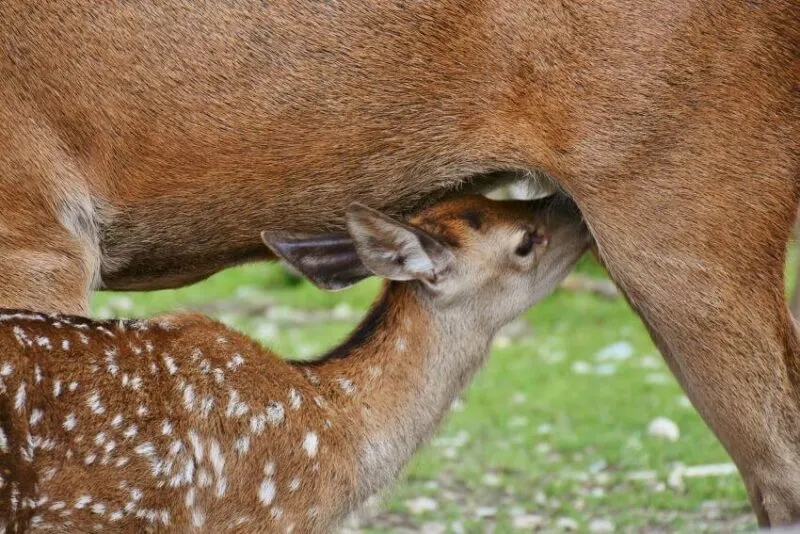
Deer are mammals with an average gestation period of 200 to 205 days. However, others, like the roe deer, have a gestation period extending up to 290 days. These variations are mainly due to species and sometimes seasons.
A female deer might have up to 2 or 3 fawns in the spring. After this, the fawns, usually brown with white spots, will grow into adults and become part of the herd.
The female deer raise fawns for the first short section of their lives. As for the male deer, it has no influence on this period.
See Related: Importance of Wildlife Conservation
7. Only the Chinese water deer have fangs instead of antlers
The Chinese water deer is one of the few species without antlers for protection. This rare type of deer prefers to live in or near wetland areas. And it can only be found in parts of China and Korea where conditions are ideal.
The water deer is a smaller species that have adapted over time to have fangs (canine teeth that can be as long as 8 cm) instead of antlers. Water deer use their fangs much like most other deer species use their antlers.
In combat, the water deer relies on its fangs to repel its opponent. It is considered one of the most vulnerable deer species in the world.
These species of deer have excellent swimming skills. That is needed to survive wetlands.
See Related: Do Deer Eat Hydrangeas?
8. Male deer shed their antlers once a year.
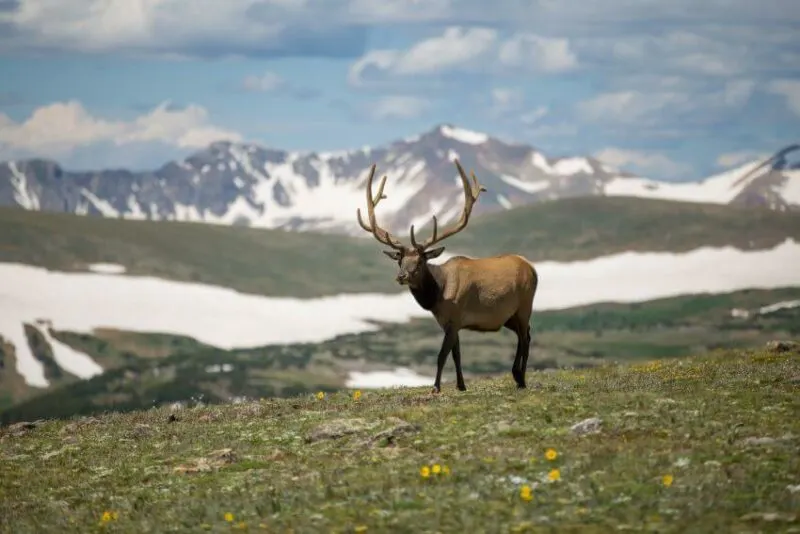
Antlers are one of the defining characteristics of the male deer species. The rare Chinese water deer is the only exception to this and instead has fangs.
Only male deer grow antlers. Each year, these antlers fall off, and the deer spend the rest of the year regrowing them for the next cycle. Antlers grow as testosterone levels rise and drop when testosterone drops in winter.
As the antlers grow, they develop a furry coat cover called velvet. This velvet cover is rich in blood vessels and nerves, allowing the antlers to regrow faster. Deer antlers grow quickly as they are composed of tissues that grow faster than any other tissue.
The antlers are formed from the same substances that strengthen our nails. Deer use them for defense during the mating season as they fight over does and sometimes as tools. Most of the antlers you see for sale have been harvested sustainably.
See Related: Animals That Start With X
9. Deer can jump – and pretty high, too
Deer are mobile, making them ideal for living in several of the world’s ecosystems, from snowy mountain ranges to wetlands. And it’s not just their special hooves that contribute to this, but their ability to jump.
The average deer can jump up to 10 feet high and also can leap further forward at high speeds. In fact, the whitetail deer can jump up to 15 feet.
The ability to leap and jump is used to get around and escape from their natural predators.
See Related: How Do Animals Adapt to Their Environment?
10. Deer can be swift
Deer aren’t just good at jumping but also have speed on their side. Some deer species can achieve up to 35 miles per hour over a short distance.
This short sprint is enough to get them away from most of their predators in nature, including mountain lions, coyotes, and bobcats.
Unfortunately, habitat loss and hunting are the biggest threats to the world’s deer species. Ecological damage and human interference are more difficult to outrun.
See Related: List of Animals That Mate for Life
11. The white-tailed deer is the most common deer species
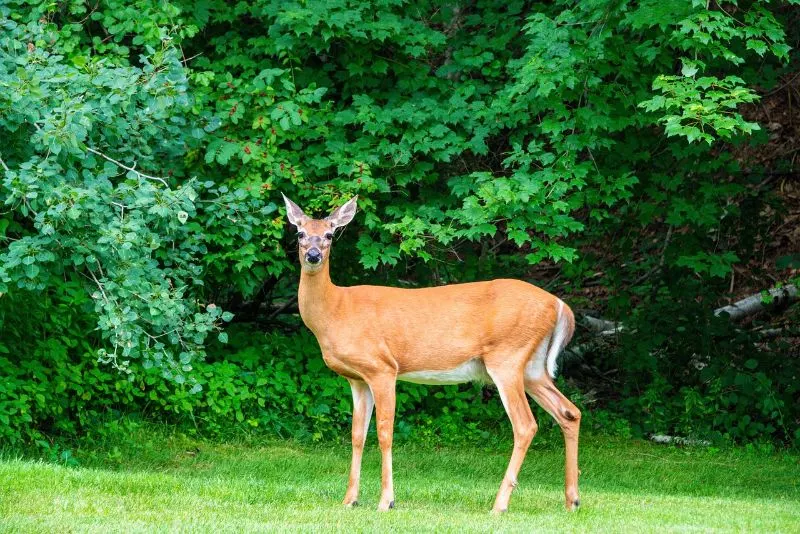
The whitetail deer is the most common type of deer species in the world. They are commonly found throughout Central, North, and South America.
In North America alone, there are over 30 million whitetail deer. And Texas has the largest number of these animals. Hunting has, however, drastically cut the total number found in nature.
The whitetail deer is also one of the smallest deer species in North America. Also, it’s the most active species and is always on the move at dusk, nighttime, and dawn.
Its ears are said to rotate up to 180°. This helps it to listen in front and behind for predators, especially at night.
Luckily, it has adaptation skills that help protect itself from predators. For example, it can sprint at 30 miles an hour and jump as high as 10 feet. Also, like most species, whitetail deer have an excellent sense of smell and hearing.
In the wild, the whitetail deer can survive up to 4.5 years. And in captivity, it can live up to 14 years.
The whitetail deer are solitary creatures. During summer, they prefer to live alone and only come together in mating season. If you spot multiple deer flocking together, chances are they are either a doe and its fawns or a small group of young bucks.
The whitetail deer have large ears, and it’s easy to confuse a mule deer for a whitetail deer though mules’ ears are larger. Their most obvious difference is the tail.
See Related: Best Books on Endangered Species
12. Scotland has a deer species of its own
Deer adapt well to ecosystems like mountains and wetlands. It means that species of deer can be found on almost every continent on the planet. Even Scotland has its native type of deer.
The red deer is found mainly in Scotland and is one of the largest deer species found in nature.
Why is it called a red deer? Instead of the brownish shades that characterize most deer species, the Scottish deer is a brilliant shade of red.
See Related: Animals That Start With I
13. The doe takes the primary care role until the fawns are ready for adulthood.
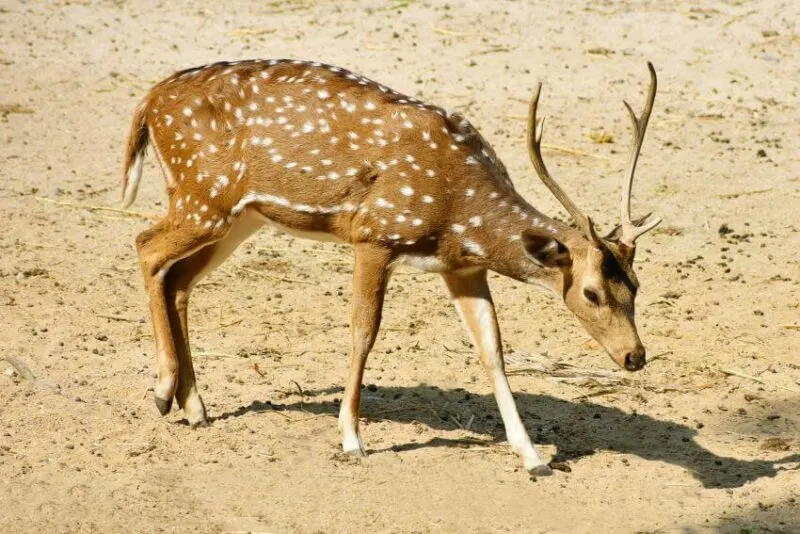
There are many mammal species on the planet where the caring role is taken on by the male of the species or shared by both parents. Deer are an exception to this common natural rule.
The male deer takes no role in the care of fawns. The doe does all the work until the fawns are ready for adulthood.
See Related: Reason Why Biodiversity is Important to Ecosystems
14. Deer are harmless to humans, but death by deer is more likely than being killed by a shark.
Deer are vegetarians and will not go out of their way to cause any harm to humans. But let’s all remember that deer are still wild animals, and accidents can happen if you venture into their natural habitat alone. The official odds of death by deer is 1 in 1.4 million.
While deer don’t mean any harm, you are more likely to be harmed by a deer than you are to be killed by a shark. That’s just the statistics of nature.
According to the CDC, deer are responsible for an estimated 120 deaths yearly. Even more, people are injured. Unfortunate accidents happen, especially car accidents, due to deer in
: deer are still wild animals and should always be handled with the necessary caution.
See Related: Three-Letter Animals You’ve Probably Never Heard Of
15. A rare type of Vietnamese was rediscovered in 2019.
Long thought to be extinct, the silver-back chevrotain was rediscovered in Southern Vietnam in 2019. This rare type of deer is small and native to the area but was thought to be entirely extinct for several decades until its recent discovery.
Protective efforts aim to preserve the silver-back chevrotain for future generations by increasing the numbers.
See Related: Why Do Animals Like Being Pet?
16. Deer species are vegetarian.
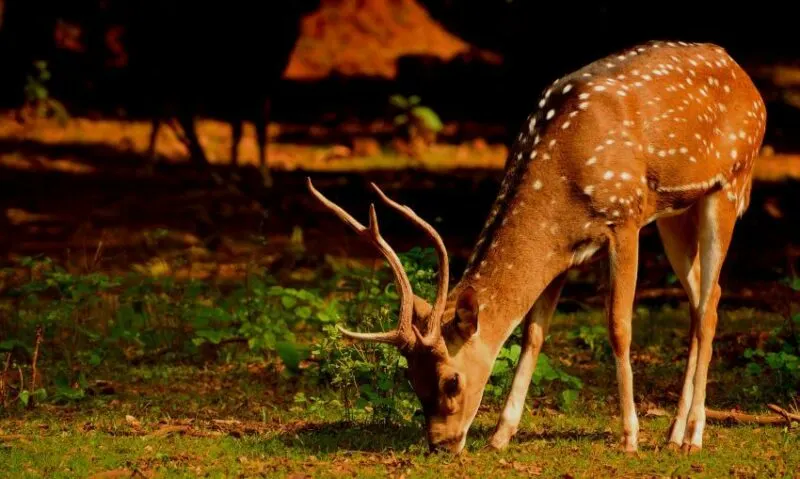
Deer are entirely vegetarian and one of nature’s most eco-friendly creatures. Deer feed on almost any plant, including grasses, mangroves, the bark of young trees, berries, and vegetables.
During summer and spring, deer eat flowers, buds, leafy green plants, and other seasonal crops
Deer leave almost no carbon footprint on the environment in their natural habitat. Their vegetarian nature makes them friendly for the parts of the world where they occur.
17. Deer have an incredible sense of smell
If you thought your sense of smell was good, think again. A deer’s sense of smell is up to 1000 times stronger than that of humans. This allows them to detect scents up to several miles away.
It’s no surprise that these wild animals stay on the lookout for predators and danger. Their unique smelling ability also helps deer know when to migrate or when food sources are nearby. While it might seem like a fun fact, this ability can also be unfavorable because it allows deer to detect hunters quickly in their area with ease.
FAQs
What are 5 facts about deer?
Deer are a family of mammals that belong to the Cervidae family.
Deer are found all over the world, except in Antarctica and Australia.
There are over 90 different species of deer, including the white-tailed deer, elk, and moose.
Deer have a keen sense of smell and hearing, which helps them detect predators.
Male deer, called bucks, grow antlers every year and use them to fight other males during mating season.
Deer are herbivores and primarily eat grass, leaves, and twigs.
What can deer do?
Deer are a type of mammal that is known for their agility and speed. They are capable of running up to 45 miles per hour and can jump up to 10 feet high. Additionally, deer are known for their keen sense of smell and excellent hearing, which they use to detect predators and other potential threats in their environment.
What are deer special abilities?
Deer are a type of mammal known for their agility and grace. Their special abilities include excellent vision and hearing, as well as the ability to run at high speeds and jump great distances. These abilities help them evade predators and survive in their natural habitats.
Deer species
Deer species are a group of mammals that belong to the family Cervidae. They are characterized by their long legs, antlers, and herbivorous diet. There are over 90 different species of deer found throughout the world, with the most common being the white-tailed deer, mule deer, and red deer.
Deer species are important both ecologically and economically, as they play a vital role in many ecosystems and are hunted for their meat and antlers.
